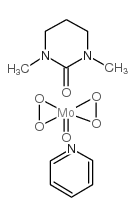氧二过氧(吡啶)(1,3-二甲基-3,4,5,6-四氢-2(1H)-嘧啶酮)钼(IV) ,Oxodiperoxy(pyridine)(1,3-dimethyl-3,4,5,6-tetrahydro-2(1H)-pyrimidinone)molybdenum(IV) ,≥98%
产品编号:Bellancom-B286795| CAS NO:128575-71-3| 分子式:C11H17MoN3O6| 分子量:383.22900
本网站销售的所有产品仅用于工业应用或者科学研究等非医疗目的,不可用于人类或动物的临床诊断或者治疗,非药用,非食用,
| 英文名称 | Oxodiperoxy(pyridine)(1,3-dimethyl-3,4,5,6-tetrahydro-2(1H)-pyrimidinone)molybdenum(IV) |
|---|---|
| CAS编号 | 128575-71-3 |
| 精确质量 | 385.01700 |
| PSA | 103.63000 |
| LogP | 0.93870 |
| 稳定性 | 遵照规定使用和储存则不会分解。 |
| 储存条件 | 密闭于阴凉干燥环境中 |
相关文档
化学品安全说明书(MSDS)
下载MSDS质检证书(COA)
相关产品
| 风险声明 (欧洲) | R8 |
|---|---|
| 安全声明 (欧洲) | 17-26-36/37/39 |
| 危险品运输编码 | UN 1479 |
|
Section 1: Product Identification Chemical Name:Oxodiperoxy(pyridine)(1,3-dimethyl-3,4,5,6-tetrahydro-2(1H)-pyrimidinone)molybdenum (IV), min. 95% CAS Registry Number:128575-71-3 Formula:MoO5(C5H5N)(C6H12N2O) EINECS Number:none Chemical Family:organometallic compound Synonym:None
Section 2: Composition and Information on Ingredients IngredientCAS NumberPercentACGIH (TWA)OSHA (PEL) Title Compound128575-71-3100%10mg/m3 (as15mg/m3 (as Section 3: Hazards Identification Emergency Overview:Strong oxidizer. Irritating to skin, eyes and respiratory tract. May be harmful if swallowed or inhaled. Primary Routes of Exposure:Ingestion, skin, eyes Eye Contact:Causes irritation to the eyes. Skin Contact:Causes redness and irritation to the skin. Inhalation:Severly irritating to the nose, mucous membranes and respiratory tract. Ingestion may cause burns and edema of the gasto-intestinal system; shock with fall of blood pressure. May Ingestion: be fatal. Ingestion causes severe irritation of the throat, abdominal pain and swelling of the throat. Irritating to skin, Acute Health Affects: eyes and respiratory tract. Chronic Health Affects:No information on long term exposure. NTP:No IARC:No OSHA:No SECTION 4: First Aid Measures Immediately flush the eyes with copious amounts of water for at least 10-15 minutes. A victim may need Eye Exposure: assistance in keeping their eye lids open. Get immediate medical attention. Wash the affected area with water. Remove contaminated clothes if necessary. Seek medical assistance if Skin Exposure: irritation persists. Remove the victim to fresh air. Closely monitor the victim for signs of respiratory problems, such as difficulty Inhalation: in breathing, coughing, wheezing, or pain. In such cases seek immediate medical assistance. Seek medical attention immediately. Keep the victim calm. Give the victim water (only if conscious). Induce Ingestion: vomiting only if directed by medical personnel. SECTION 5: Fire Fighting Measures Flash Point:not applicable Autoignition Temperature:none Explosion Limits:none Extinguishing Medium:carbon dioxide, dry powder or foam If involved in a fire, fire fighters should be equipped with a NIOSH approved positive pressure self-contained Special Fire Fighting Procedures: breathing apparatus and full protective clothing. Hazardous Combustion andIf involved in a fire this material may emit toxic organic fumes. Decomposion Products: Unusual Fire or Explosion Hazards: Material may react violently with reducing agents or fuels. Oxidizer. SECTION 6: Accidental Release Measures Spill and Leak Procedures:Small spills can be mixed with vermiculite or sodium carbonate and swept up. SECTION 7: Handling and Storage Handling and Storage:Store in a sealed amber container. Avoid prolonged contact with light. Store cold. SECTION 8: Exposure Controls and Personal Protection Eye Protection:Always wear approved safety glasses when handling a chemical substance in the laboratory. Skin Protection:Wear appropriate chemical resistant gloves and clothing. Ventilation:Material may form a fine dust. If possible, handle the material in an efficient fume hood. If in form of fine dust and ventilation is not available a respirator should be worn. The use of respirators Respirator: requires a Respirator Protection Program to be in compliance with 29 CFR 1910.134. Ventilation:Material may form a fine dust. If possible, handle the material in an efficient fume hood. Additional Protection:No additional protection required. SECTION 9: Physical and Chemical Properties Color and Form:pale yellow xtl Molecular Weight:383.21 Melting Point:decomposes Boiling Point:no data Vapor Pressure:no data Specific Gravity:no data Odor:none Solubility in Water:insoluble SECTION 10: Stability and Reactivity Stability:light-senstive, heat sensitive Hazardous Polymerization:no hazardous polymerization Conditions to Avoid:Avoid contact with heat and reducing agents Reducing agents and fuels. Phosphorus, sulfur and halogens. Material may decompose violently if heated. Incompatibility: Reacts violently with DMSO. Decomposition Products:Carbon dioxide, carbon monoxide, organic vapors, soot, and molybdenum oxides. SECTION 11: Toxicological Information RTECS Data:No information available in the RTECS files. Carcinogenic Effects:No data available Mutagenic Effects:No data available Tetratogenic Effects:No data available SECTION 12: Ecological Information Ecological Information:No information available SECTION 13: Disposal Considerations Disposal:Dispose of according to local, state and federal regulations. SECTION 14: Transportation Shipping Name (CFR):Oxidizing Solid, N.O.S. Hazard Class (CFR):5.1 Additional Hazard Class (CFR):NA Packaging Group (CFR):II UN ID Number (CFR):UN# 1479 Shipping Name (IATA):Oxidizing Solid, N.O.S. Hazard Class (IATA):5.1 Additional Hazard Class (IATA):NA Packaging Group (IATA):II UN ID Number (IATA):UN# 1479 SECTION 15: Regulatory Information TSCA:Not listed in the TSCA inventory. SARA (Title 313):Title compound not listed. Second Ingredient:none SECTION 16 - ADDITIONAL INFORMATION N/A |








 浙公网安备 33010802013016号
浙公网安备 33010802013016号